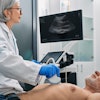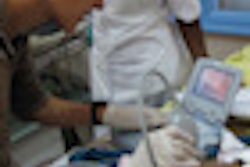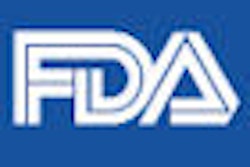Doppler ultrasound may be a viable screening tool to help diagnose infants with allergies to cow's milk, suggests an article published online in the June issue of the American Journal of Roentgenology.
Approximately 2.5% to 7.5% of infants develop this allergy, but it can be difficult to diagnose due to a variety of symptoms. Infants suspected of having cow's milk allergies are placed on an exclusion diet for several weeks, which is followed by a challenge test.
Physicians at the Hospital São Lucas da Pontifícia Universidade Católica do Rio Grande do Sul in Porto Alegre, Brazil, conducted a study to evaluate the effectiveness of grayscale and color Doppler ultrasound for identifying intestinal inflammation caused by the allergy (AJR, June 2011, Vol. 196:6, pp. W817-W822).
Seventeen symptomatic and 17 asymptomatic infants 6 months of age and younger were recruited for the study. The diet of all 34 infants included cow's milk. Irritability (100%) and vomiting (70%) were the most frequently reported symptoms.
An ultrasound exam was performed when an infant came to the Serviço de Gastroenterologia Pediátrica between May 2006 and July 2009 for treatment (study group) or for a routine checkup (control group). The grayscale ultrasound exam measured the thickness of the wall of bowel loops in the jejunum, terminal ileum, and all colon segments.
The color Doppler test evaluated the quantity of peripheral mesenteric vessels in a 4-cm2 area. Five areas were examined in right side and five in the left side of the abdomen to examine the ileal and jejunal regions, according to lead author Dr. Matias Epifanio and colleagues.
All colored areas were classified as vessels, and vessel density in the surface was evaluated using public domain image analysis software (ImageJ, U.S. National Institutes of Health). A value of 0% to 100%, the percentage of vessel density, was obtained from the vascularized area.
Symptomatic infants were then placed on a diet of amino acid-based formula, after which 15 of the 17 infants had an evaluation in the pediatric gastroenterology department and a second set of ultrasound examinations. After being fed cow's milk in a challenge test lasting up to a week, the infants underwent a third ultrasound exam.
The percentage of mesenteric vessel density according to color Doppler scans in patients suspected of having cow's milk allergies (mean, 28.1%) was significantly greater than in the control infants (mean, 7.8%), the authors reported.
Epifanio and colleagues recommended a cutoff point of 18.7% for vessel density. At this cutoff point, patients with cow's milk allergies could be differentiated from those without allergies with 81.8% sensitivity and 94.1% specificity.
"Ultrasound findings, particularly vessel density, seem to be associated with inflammatory changes in the intestinal wall," the authors wrote. "The physiopathologic mechanism of cow's milk allergy in infants is usually associated with intestinal inflammation, and ultrasound may detect these changes."
When associated with clinical parameters, Doppler ultrasound examinations may be useful as a screening tool, they concluded.



















